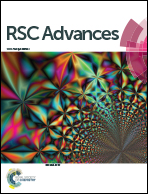Facile controlled synthesis of a hierarchical porous nanocoral-like Co3S4 electrode for high-performance supercapacitors†
Abstract
A facile one-step hydrothermal process is developed to synthesize a porous nanocoral-like Co3S4, which directly grows on a three dimensional (3D) macroporous nickel (Ni) foam. The scanning electron microscopy (SEM) images reveal the uniform formation of a Co3S4 nanocoral cluster on Ni foam with a hierarchical porous structure. The crystal growth mechanism and factors that influence the formation of the coral-like Co3S4 directly on Ni foam have been further studied. The subsequent electrochemical measurements demonstrate that the nanocoral-like Co3S4 as a binder-free electrode for supercapacitors possesses a large specific capacitance as high as 1559 F g−1 at a current density of 0.5 A g−1 in 2.0 M KOH aqueous electrolyte. Moreover, to confirm its practical application, an asymmetric supercapacitor is assembled with the nanocoral-like Co3S4 electrode as the positive electrode and activated carbon (AC) as the negative electrode. Such a device achieves a high energy density of 60.1 W h kg−1 at a power density of 418.2 W kg−1 and maintains 38.5 W h kg−1 at a high power density of 3812.5 W kg−1, suggesting that the presented nanocoral-like Co3S4 electrode not only has potential for applying in high energy density fields, but also in high power density applications.


 Please wait while we load your content...
Please wait while we load your content...